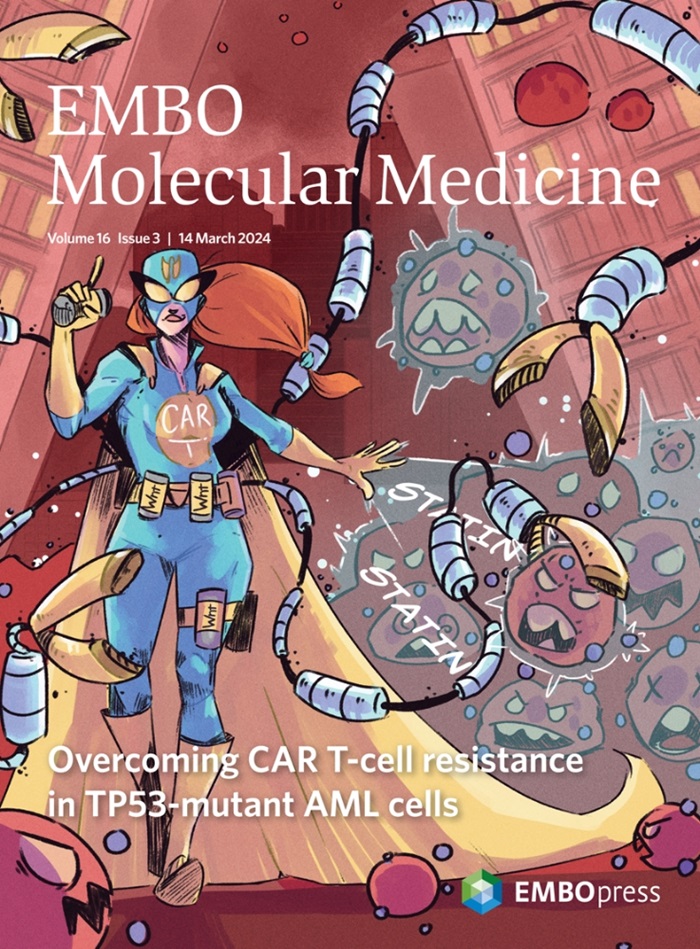MicroRNA-33 inhibition ameliorates muscular dystrophy by enhancing skeletal muscle regeneration.
IF 9
1区 医学
Q1 MEDICINE, RESEARCH & EXPERIMENTAL
引用次数: 0
Abstract
Muscular dystrophy is a group of diseases characterized by progressive weakness and degeneration of skeletal muscles, for which there is currently no cure. Here, we show that microRNA (miR)-33a/b play a crucial role in muscle regeneration. miR-33a was upregulated during myoblast differentiation and in skeletal muscles of mdx mice, a genetic model of Duchenne muscular dystrophy (DMD). miR-33a deficiency enhanced muscle regeneration response to cardiotoxin injury and attenuated muscle degeneration and fibrosis in mdx mice. Conversely, a humanized mouse model expressing miR-33a and miR-33b showed exacerbated muscle degeneration and fibrosis. Mechanistically, miR-33a/b inhibited satellite cell proliferation, leading to reduced muscle regeneration and increased fibrosis by targeting Cdk6, Fst, and Abca1. Local and systemic administration of anti-miRNA oligonucleotides targeting miR-33a/b ameliorated the dystrophic phenotype in mdx mice. Furthermore, miR-33b inhibition upregulated these target genes in myotubes differentiated from human induced pluripotent stem cells derived from a patient with DMD. These findings indicate that miR-33a/b are involved in muscle regeneration and their inhibition may represent a potential therapeutic strategy for muscular dystrophy.抑制MicroRNA-33通过增强骨骼肌再生来改善肌肉萎缩症。
肌萎缩症是一组以骨骼肌进行性无力和退化为特征的疾病,目前尚无治愈方法。在这里,我们发现microRNA (miR)-33a/b在肌肉再生中起着至关重要的作用。miR-33a在成肌细胞分化和mdx小鼠骨骼肌中上调,mdx小鼠是杜氏肌营养不良症(DMD)的遗传模型。miR-33a缺乏增强了mdx小鼠对心脏毒素损伤的肌肉再生反应,减轻了肌肉变性和纤维化。相反,表达miR-33a和miR-33b的人源化小鼠模型显示肌肉变性和纤维化加剧。在机制上,miR-33a/b通过靶向Cdk6、Fst和Abca1抑制卫星细胞增殖,导致肌肉再生减少和纤维化增加。局部和全身给药靶向miR-33a/b的抗mirna寡核苷酸可改善mdx小鼠的营养不良表型。此外,miR-33b抑制上调了来自DMD患者的人诱导多能干细胞分化的肌管中的这些靶基因。这些发现表明,miR-33a/b参与肌肉再生,其抑制可能代表了肌营养不良的潜在治疗策略。
本文章由计算机程序翻译,如有差异,请以英文原文为准。
求助全文
约1分钟内获得全文
求助全文
来源期刊

EMBO Molecular Medicine
医学-医学:研究与实验
CiteScore
17.70
自引率
0.90%
发文量
105
审稿时长
4-8 weeks
期刊介绍:
EMBO Molecular Medicine is an open access journal in the field of experimental medicine, dedicated to science at the interface between clinical research and basic life sciences. In addition to human data, we welcome original studies performed in cells and/or animals provided they demonstrate human disease relevance.
To enhance and better specify our commitment to precision medicine, we have expanded the scope of EMM and call for contributions in the following fields:
Environmental health and medicine, in particular studies in the field of environmental medicine in its functional and mechanistic aspects (exposome studies, toxicology, biomarkers, modeling, and intervention).
Clinical studies and case reports - Human clinical studies providing decisive clues how to control a given disease (epidemiological, pathophysiological, therapeutic, and vaccine studies). Case reports supporting hypothesis-driven research on the disease.
Biomedical technologies - Studies that present innovative materials, tools, devices, and technologies with direct translational potential and applicability (imaging technologies, drug delivery systems, tissue engineering, and AI)
 求助内容:
求助内容: 应助结果提醒方式:
应助结果提醒方式:


